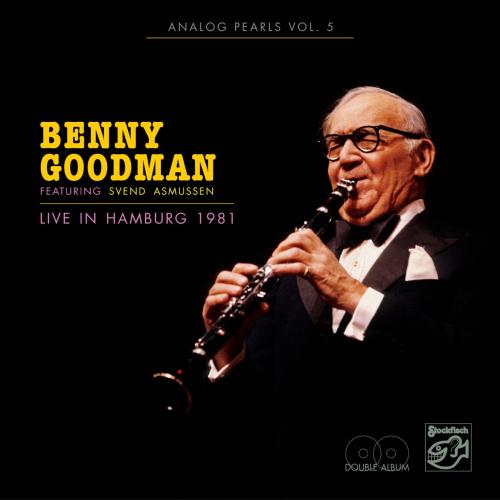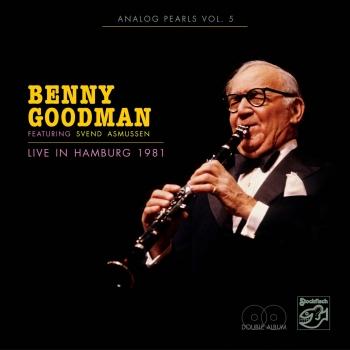
Live in Hamburg 1981 (Remastered) Benny Goodman
Album info
Album-Release:
2020
HRA-Release:
28.08.2020
Album including Album cover Booklet (PDF)
- 1 After You've Gone (Live) 05:30
- 2 If I Had You (Live) 03:07
- 3 Avalon (Live) 05:03
- 4 Careless Love (Live) 05:46
- 5 The Days of Wine and Roses (Live) 06:31
- 6 Hush-A-Bye (Live) 05:22
- 7 Sweet Georgia Brown (Live) 05:02
- 8 I Want to Be Happy (Live) 05:05
- 9 Here's That Rainy Day (Live) 02:54
- 10 Oh, Lady Be Good (Live) 04:59
- 11 Nuages (Live) 06:14
- 12 Airmail Special (Live) 05:08
- 13 On the Sunny Side of the Street (Live) 02:59
- 14 Don't Be That Way (Live) 04:29
- 15 Body and Soul (Live) 04:21
- 16 How High the Moon (Live) 03:49
- 17 The World Is Waiting for the Sunrise (Live) 04:20
- 18 Sing, Sing, Sing (With a Swing) (Live) 06:55
- 19 Goodbye (Live) 02:10
- 20 It's Easy to Remember (Live) 02:20
Info for Live in Hamburg 1981 (Remastered)
This recording of one of Benny Goodman's last concerts in Germany (which was held for NDR's "Sunday Concerts" series) is much more than a newly discovered collector's item for fans of the eternally young American swing tradition. Using minimal recording equipment, Günter Pauler made an exciting and even touching sound-document of Goodman's worldclass playing at the Hamburg Congress Centre on his last European tour in 1981. The impressive interplay between the (then) young Danish and Belgian musicians and the old master of classic jazz on the large stage of the CCH Hamburg showcases great mutual playing synergy and class.
Accompanied by a quintet of Danish top musicians including the violinist Svend Asmussen (who died in 2017) plus the Belgian guitarist Philip Catherine, Goodman's rather traditional clarinet tone comes together with pulsing European jazz to create a surprisingly captivating result. Even after thousands of shows, Goodman still manages to coax exciting moments out of songs from the worldwide jazz canon ranging from "After You've Gone" to the legendary "Sing, Sing, Sing". Whether in an intimate duet with the violinist and vibraphonist Svend Asmussen, or playing "Lady Be Good" with the whole band, the old-master allows his younger accompanying musicians plenty of room for individual interpretation and still drives the quintet repeatedly back to the dance floor of the American swing of the 30s. Goodman's legacy: "It's Easy To Remember", one man, one clarinet, one melody. An ecstaticly swinging evening, captured perfectly and impressively." (Axel Janssen)
Benny Goodman, clarinet
Svend Asmussen, violin, vibraphone
Philip Catherine, guitar
Claes Crona, piano
Mads Vinding, bass
Bjarne Rostvold, drums
Digitally remastered
Benny Goodman
For a kid who liked jazz, Chicago was a great town to grow up in. Musicians had begun working their way north from New Orleans about the turn of the century, and by the early 1920s giants like "Jellyroll" Morton, Sidney Bechet, "King" Oliver and Louis Armstrong were playing in Chicago and making history.
Kids who paid attention to this development were going to make history themselves in a few more years - Bud Freeman, Davie Tough, Eddie Condon, Milt Mesirow (Mezz Mezzrow), Gene Krupa, "Muggsy" Spanier, Jimmy McPartland, Jess Stacy - and a kid in short pants who played the clarinet.
Benny Goodman was only 10 when he first picked up a clarinet. Only a year or so later he was doing Ted Lewis imitations for pocket money. At 14 he was in a band that featured the legendary Bix Beiderbecke. By the time he was 16 he was recognized as a "comer" as far away as the west coast and was asked to join a California-based band led by another Chicago boy, Ben Pollack.
Goodman played with Pollack's band for the next four years. His earliest recording was made with Pollack, but he was also recording under his own name in Chicago and New York, where the band had migrated from the west coast. In 1929, when he was just 20, Benny struck out on his own to become a typical New York freelance musician, playing studio dates, leading a pit orchestra, making himself a seasoned professional.
By 1934 he was seasoned enough to be ready for his first big break. He heard that Billy Rose needed a band for his new theatre restaurant, the Music Hall, and he got together a group of musicians who shared his enthusiasm for jazz. They auditioned and got the job.
Then Benny heard that NBC was looking for three bands to rotate on a new Saturday night broadcast to be called "Let's Dance," a phrase that has been associated with the Goodman band ever since. One band on the show was to be sweet, one Latin, and the third hot. The Goodman band was hot enough to get the job, but not hot enough to satisfy Benny. He brought in Gene Krupa on drums. Fletcher Henderson began writing the arrangements - arrangements that still sound fresh more than a half century later. And the band rehearsed endlessly to achieve the precise tempos, section playing and phrasing that ushered in a new era in American music. There was only one word that could describe this band's style adequately: Swing. www.bennygoodman.com
Booklet for Live in Hamburg 1981 (Remastered)









